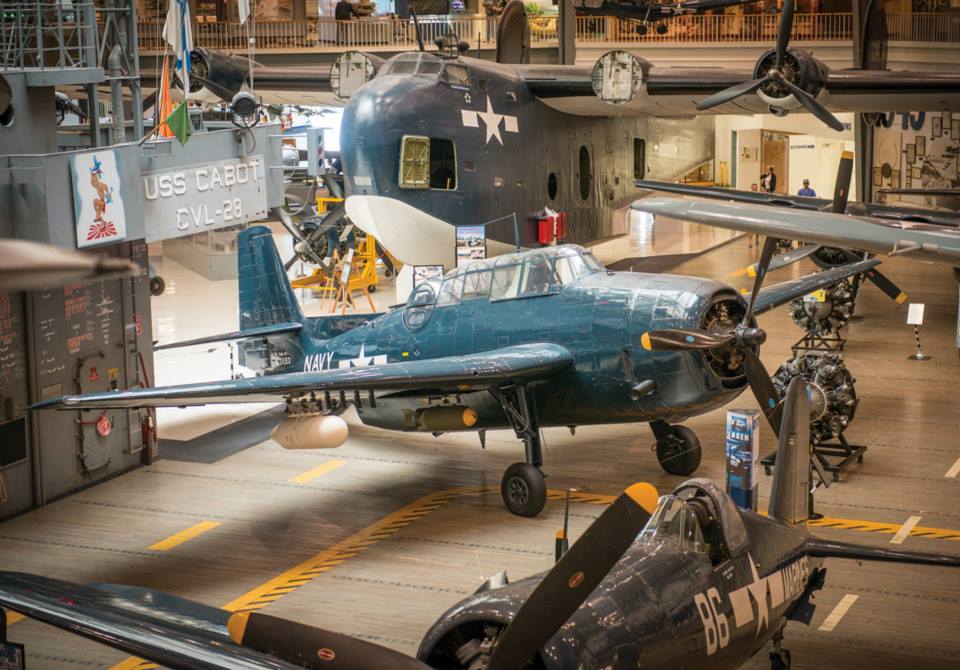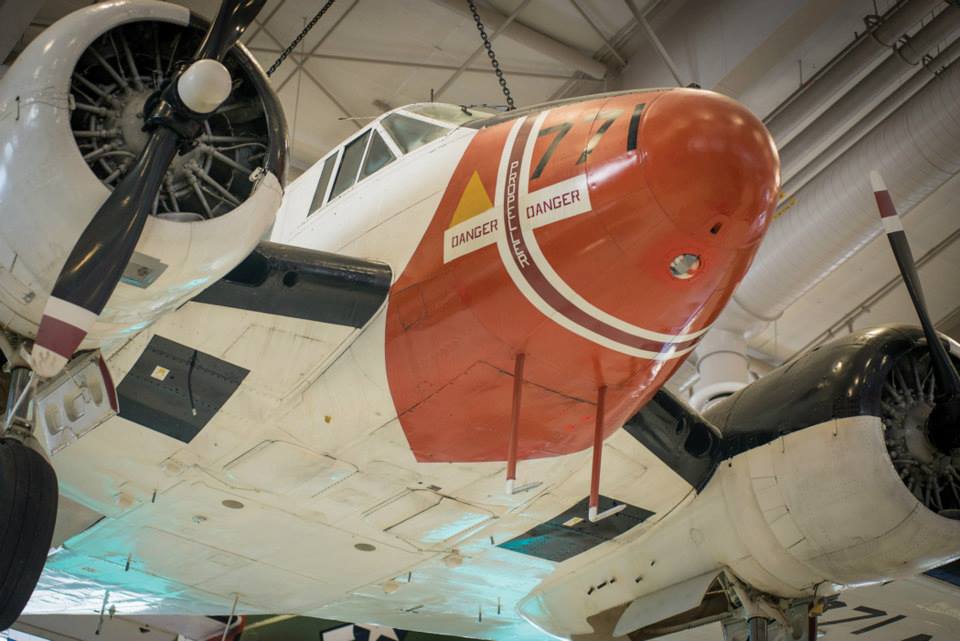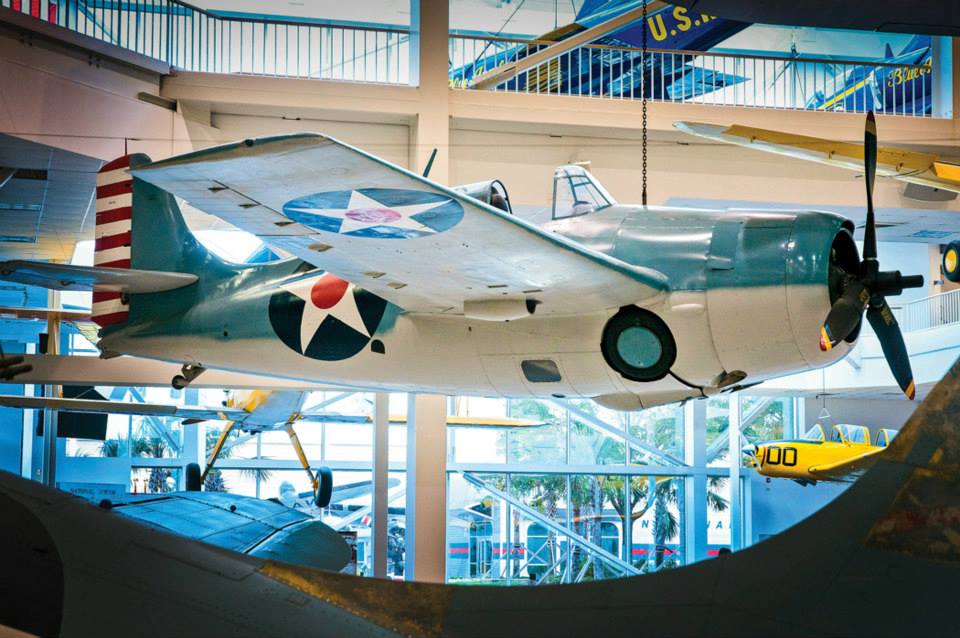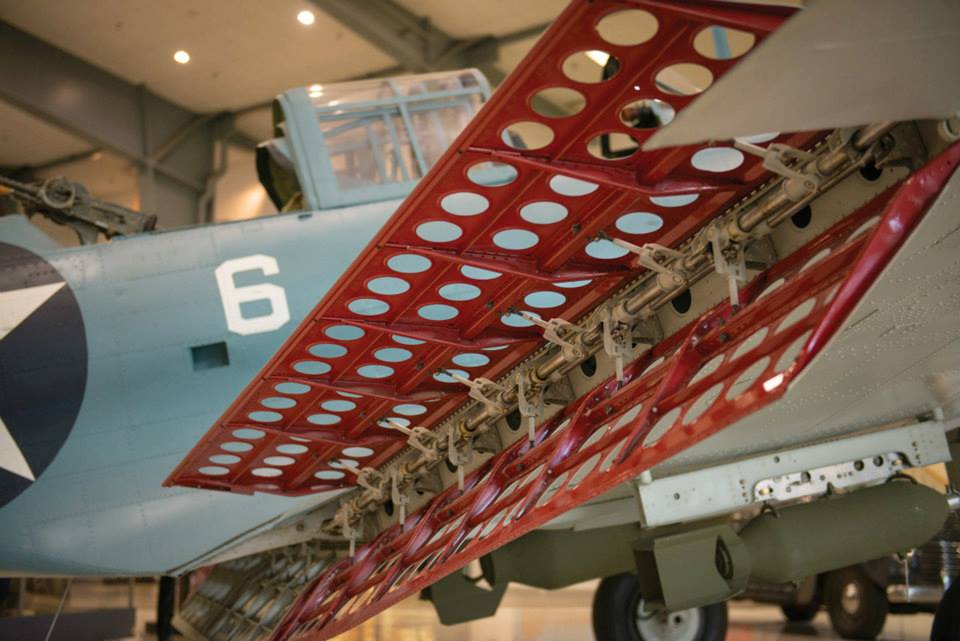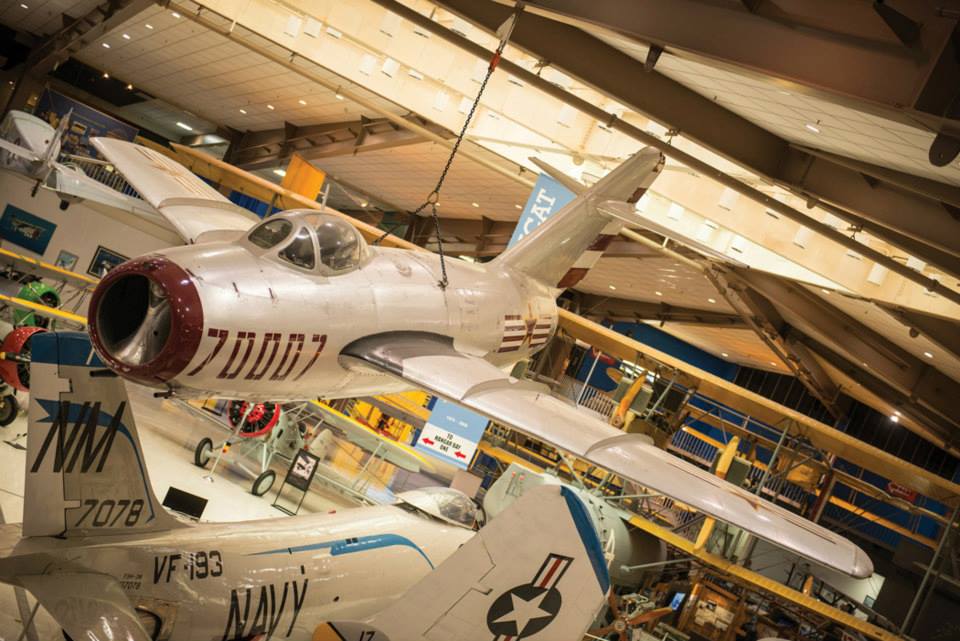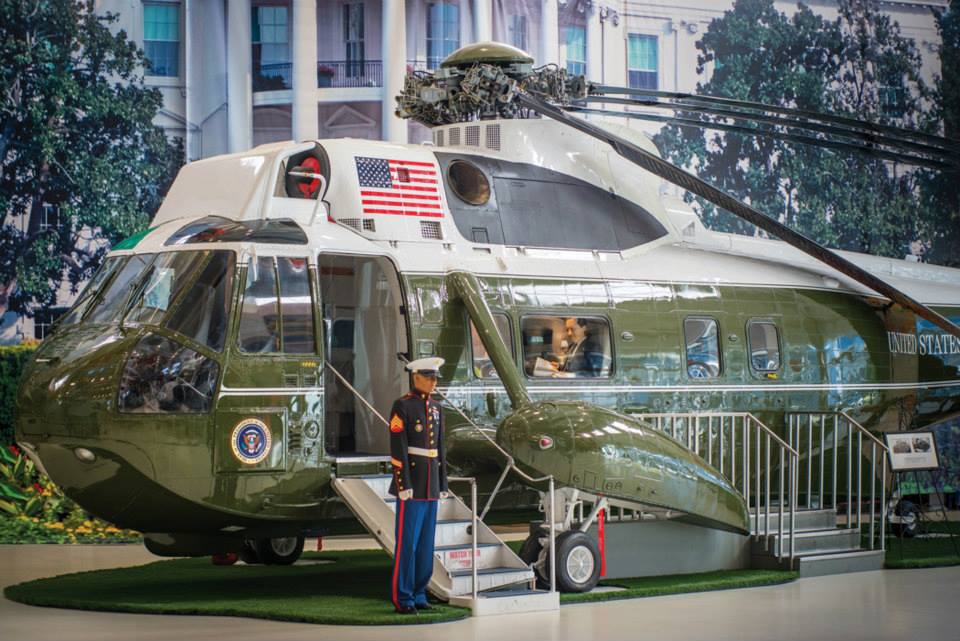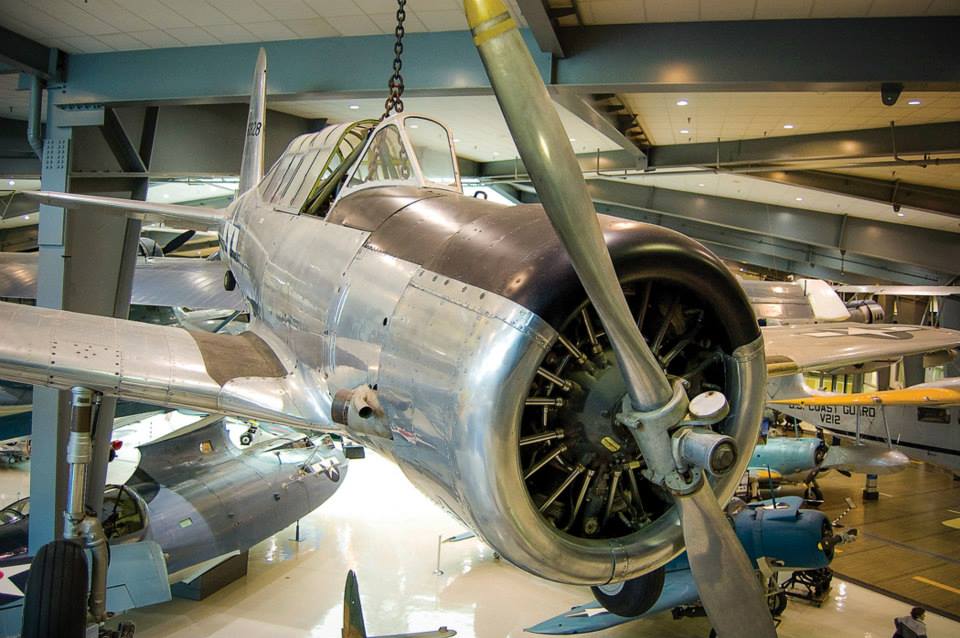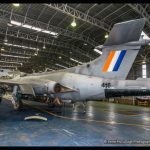(Image Credit: National Naval Aviation Museum)
In conjunction with the celebration of it’s 50th Anniversary, the National Naval Aviation Museum has released an all-new book. Entitled National Naval Aviation Museum Aircraft Collection, the book features all-new photography, and covers the museum’s new exhibits and new aircraft in addtion to long-standing favorites within the museum’s collection, documenting the full span of naval aviation history as displayed at the world-class facility. The book contains over 300 photographs of the museum’s aircraft and includes descriptions, statistics and specifications.
Professionally photographed by Michael Duncan, the book provides a refreshingly non-digital tour through the museum’s extensive collection. As it’s a primarily pictorial guide, we’ll shut up now and let you see some of the beautiful shots of the museum’s collection that are featured within the book.
Accepted by the Navy on February 20, 1942 as a JRB-2 Expeditor, the museum’s aircraft (BuNo 09771) initially served as a utility plane with the Marine Corps units at MCAS Quantico, and NAS San Diego. Following World War II it flew at NAS Corpus Christi, NAS Alameda, and NAS Anacostia in Washington DC before being placed in storage in 1948. Re-entering active service again in 1950, the aircraft underwent conversion to the SNB-5P Navigator and later to the RC-45J designation and served until June 29, 1972, when it was retired as the last aircraft of its type then flying in the US Navy.
(Image Credit: National Naval Aviation Museum)
The F4F-3A was a variant of the F4F-3. It was lighter than the F4F-3, but lacked some of the performance of the -3 model, having reduced supercharging and intercooling in the Pratt and Whitney R 1830-90 engine chosen for it. This Grumman F4F-3A Wildcat (BuNo 3969) is the last of 65 F4F-3As delivered to the Navy and Marine Corps. Though preceded in service by the troubled Brewster F2A, the F4F-3 was the first modern fighter aircraft in widespread use. The Wildcat was deployed in both Navy and Marine squadrons in the opening Pacific battles that would eventually turn the tide against Japan in World War II.
(Image Credit: National Naval Aviation Museum)
This Battle of Midway veteran was accepted by the navy in December 1940 and assigned Bureau Number 2106. The plane was plane was parked on Ford Island in the middle of Pearl Harbor on the fateful day of the Japanese attack. Aboard the USS Lexington (CV-2), the participated in a mission on March 10, 1942 along with 103 other planes from the Lexington and Yorktown (CV-5) that earned her pilot the Navy Cross. Later assigned to Midway, on the morning of 4 June 1942, this Dauntless was one of sixteen SBD-2s launched to attack Japanese aircraft carriers to the west of the atoll. Approaching the enemy carrier Hiryu, the Marine planes came under heavy fire from antiaircraft gunners and fighters of the enemy combat air patrol. With two Zeroes on her tail, the plane released her bomb at an altitude of 800 feet, though during their egress from the target area, the Zeroes in Pursuit pursued increased to four and chased the Dauntless for miles. The plane was struck with enemy bullets 219 times, knocking out the hydraulic system and wounding the gunner. One bullet came so close that it clipped the pilot’s throat microphone cord. Nevertheless, the plane managed to return to Midway, making a one-wheel landing on the atoll, one of only eight SBD-2s to return from the attack. For their actions, the pilot received the Navy Cross and the gunner was awarded the Distinguished Flying Cross. Returned to the United States, the SBD-2 was repaired and assigned to the Carrier Qualification Training Unit at NAS Glenview in Illinois. On the morning of June 11, 1943, the aircraft was ditched in the waters of Lake Michigan during an errant approach to the training carrier USS Sable (IX 81). While the pilot was retrieved from the water by a Coast Guard rescue boat, the aircraft sank to the bottom of the lake. Recovered in 1994, the aircraft underwent extensive restoration at the museum before being placed on public display in 2001. A survivor of the Pearl Harbor attack and two extraordinary combat actions, including the famous Battle of Midway, it is one of the most historic aircraft in existence anywhere in the world.
(Image Credit: National Naval Aviation Museum)
The first MiG-15 test flight occurred in December 1948 with production beginning in 1949. The airplane was one of the first successful swept-wing jet fighters, ruling the skies over Korea early in the Korean War, but that changed in late-1950 with the appearance of the Air Force’s North American F-86 Sabre, which was able to combat the MiG on more equal terms. In addition to combat over Korea, from 1950 to 1959 MiG-15s flown by Soviet, Chinese and North Korean pilots were involved in multiple Cold War incidents that included attacks on Navy reconnaissance and patrol aircraft. The MiG-15 design served as a base for development of the MiG-17 which remained an effective threat to American aircraft over North Vietnam into the 1960s.
(Image Credit: National Naval Aviation Museum)
The museum’s VH-3A Sea King (originally designated HSS-2Z) once flew the President of the United States as one of the ‘Marine One’ helicopters. It was first delivered in 1962, one of eight VH-3As procured under Navy contract. In 1966, the museum’s aircraft was assigned to Marine Helicopter Squadron (HMX) 1 at Quantico, Virginia. That move coincided with HMX-1s Executive Flight Detachment becoming the sole provider of helicopter transport to the President of the United States, a mission which had been shared with the U.S. Army since 1957. According to the history card for this aircraft, though it served in HMX-1 beginning in 1966, it did not fly with the Executive Flight Detachment until January 1972, remaining in service in that capacity until assigned to the Navy in 1975. It finished its service with Helicopter Combat Support Squadron (HC) 2 in 2003, at which time it was transferred to the museum.
(Image Credit: National Naval Aviation Museum)
One of the aircraft that served to train an entire generation of naval aviators during World War II, Vultee Aircraft’s SNV Valiant provided flight students their first taste of a service-type airplane after many weeks spent in biplane trainers. Weighing 4,360 lb. fully loaded and boasting a top speed of just 182 miles per hour, the airplane had fixed landing gear and a tail held to the aircraft by just three bolts. While the plane was not robust enough to be utilized in aerobatic maneuvers, it was regularly employed in instrument training and formation flying. The aircraft received the moniker ‘Vultee Vibrator’ because of the way the canopy rattled with the engine running and the shudder that developed in the second and third turn of a spin. With the end of the war in 1945, all of the SNVs were quickly phased out of service.
(Image Credit: National Naval Aviation Museum)
The book is available at the museum’s on-site gift shop or can be purchased online, and if not as a souvenir of a visit to this amazing collection, this book makes a great addition to your coffee table for those of us not fortunate enough to have recently visited Pensacola.







